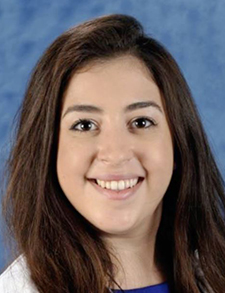
Dr. Shariati
Presenters: Katherine Soe, MD, Patrick Brady, MD, Leslie Farrell, MD, and Cristin McDermott, MD
PHM 2023 presenters opened the session by highlighting that nearly one in five children in the U.S. experience a mental health disorder and that suicide has become the second leading cause of death in 10- to 24-year-olds. The lack of availability of psychiatric practitioners along with the lack of formal hospitalist training in the treatment of mental health disorders, especially aggression and agitation, were pointed out as well.
The presenters took a case-based approach to the presentation. The first case focused on a 14-year-old female with increased agitation during her hospitalization. The presenters first emphasized the recognition of agitation as a symptom with multiple etiologies, but even more importantly they noted that agitation is a form of communication for some patients. For the management of agitation, presenters encouraged keeping a broad differential of underlying etiologies and using behavioral interventions first; they encouraged clinicians to build on the caretaker’s previous experience of such scenarios and to consider the use of home, as-needed, agitation medication. Minimal use of restraints and limiting the use of intramuscular injections were also encouraged.
The next case brought forth the topic of suicidality through an example of a 15-year-old patient who was admitted after intentional acetaminophen ingestion. Presenters reminded attendees that the safety evaluation of patients is everyone’s responsibility. They emphasized the importance of treating suicidal ideation and attempts as any other chief complaint and remembering the cruciality of the HEADSS (home, education, activities, drugs, sexuality, self-harm) assessment of our patients. Tips for the management of this group of patients included establishing a safe environment, assuring patients return to baseline and consulting psychiatry. Before closing this case, presenters reminded attendees that providing patients and families with available resources within the community is an important part of safe discharge planning.
The last two cases shifted the focus to catatonia. The presenters first highlighted the importance of recognizing catatonia and the fact that these patients are at 60 times higher risk of premature death and comorbid mood or psychotic disorders when compared to their peers. They further pointed out the importance of remembering that catatonia is always due to an underlying cause and can progress to malignant catatonia, a severe complication, and a psychiatric emergency. For the management of catatonic patients, presenters emphasized the importance of managing the underlying etiology and continuation of therapy with benzodiazepine despite sedation and sleep. The lack of availability of institutions offering electroconvulsive therapy for the pediatric population was also highlighted before the closing of the session.
Key Takeaways
- Be proactive about identifying and intervening in cases of agitation, suicidality, and catatonia through early and frequent assessments
- Keep a broad differential diagnosis in the setting of agitation and catatonia and pay special attention to the potential underlying medical processes
- Know the resources available to you and your patients within both your hospital and your surrounding community
Dr. Shariati is a second-year pediatric hospital medicine fellow at Akron Children’s Hospital in Akron, Ohio